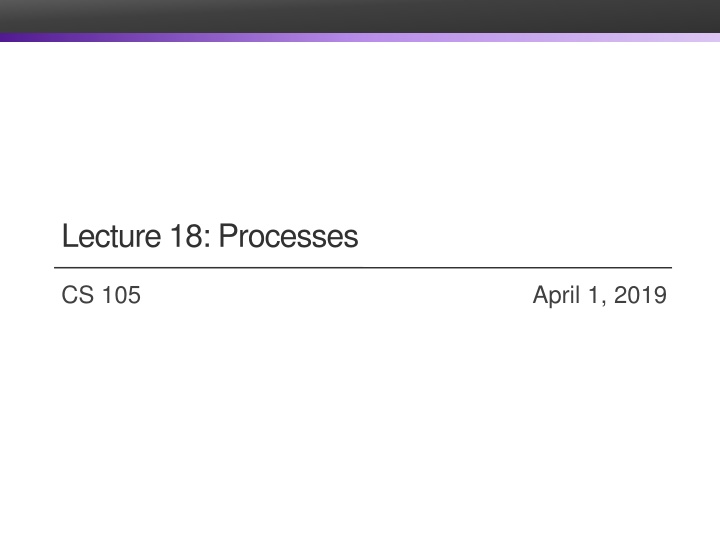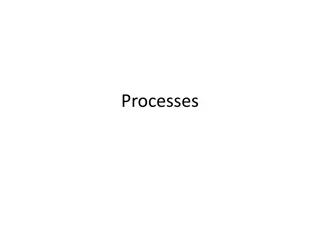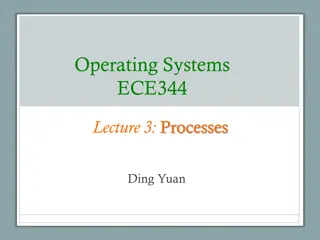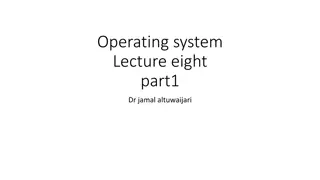Lecture 18: Processes
Processes in computer science are instances of running programs that provide each program with private address space and logical control flow. Learn about the key abstractions provided by processes, multiprogramming, multiprocessing, and the traditional reality of processes execution.
Download Presentation

Please find below an Image/Link to download the presentation.
The content on the website is provided AS IS for your information and personal use only. It may not be sold, licensed, or shared on other websites without obtaining consent from the author.If you encounter any issues during the download, it is possible that the publisher has removed the file from their server.
You are allowed to download the files provided on this website for personal or commercial use, subject to the condition that they are used lawfully. All files are the property of their respective owners.
The content on the website is provided AS IS for your information and personal use only. It may not be sold, licensed, or shared on other websites without obtaining consent from the author.
E N D
Presentation Transcript
Lecture 18: Processes CS 105 April 1, 2019
Processes Definition: A program is a file containing code + data that describes a computation Definition: A process is an instance of a running program. One of the most profound ideas in computer science Not the same as program or processor Memory Process provides each program with two key abstractions: Private address space Each program seems to have exclusive use of main memory. Provided by kernel mechanism called virtual memory Logical control flow Each program seems to have exclusive use of the CPU Provided by kernel mechanism called context switching Stack Heap Data Code CPU Registers
Multiprocessing: The Illusion Memory Memory Memory Stack Heap Data Stack Heap Data Stack Heap Data Code Code Code CPU CPU CPU Registers Registers Registers Computer runs many processes simultaneously Applications for one or more users Web browsers, email clients, editors, Background tasks Monitoring network & I/O devices
Multiprocessing Example Running program top on Mac System has 123 processes, 5 of which are active Identified by Process ID (PID)
Multiprocessing: The (Traditional) Reality Memory Stack Heap Data Stack Heap Data Stack Heap Data Code Saved registers Code Saved registers Code Saved registers CPU Registers Single processor executes multiple processes concurrently Process executions interleaved (multitasking) Address spaces managed by virtual memory system Register values for nonexecuting processes saved in memory
Multiprocessing: The (Traditional) Reality Memory Stack Heap Data Stack Heap Data Stack Heap Data Code Saved registers Code Saved registers Code Saved registers CPU Registers 1. Save current registers in memory
Multiprocessing: The (Traditional) Reality Memory Stack Heap Data Stack Heap Data Stack Heap Data Code Saved registers Code Saved registers Code Saved registers CPU Registers 1. Save current registers in memory 2. Schedule next process for execution
Multiprocessing: The (Traditional) Reality Memory Stack Heap Data Stack Heap Data Stack Heap Data Code Saved registers Code Saved registers Code Saved registers CPU Registers 1. Save current registers in memory 2. Schedule next process for execution 3. Load saved registers and switch address space (context switch)
User View of Concurrent Processes Control flows for concurrent processes are physically disjoint in time However, we can think of concurrent processes as running in parallel with each other Process A Process B Process C Time
Concurrent Processes Each process is a logical control flow. Two processes run concurrently (are concurrent) if their flows overlap in time Otherwise, they are sequential Examples (running on single core): Concurrent: A & B, A & C Sequential: B & C Process A Process B Process C Time
Context Switching Processes are managed by a shared chunk of memory- resident OS code called the kernel Important: the kernel is not a separate process, but rather runs as part of some existing process. Control flow passes from one process to another via a context switch Process A Process B user code context switch kernel code Time user code context switch kernel code user code
Process Control Block (PCB) To implement a context switch, OS maintains a PCB for each process containing: location in memory register values PC, SP, eflags/status register location of executable on disk page tables which user is executing this process process identifier (pid) process privilege level process arguments (for identification with ps) process status scheduling information ... and more!
Multiprocessing: The (Modern) Reality Memory Stack Heap Data Stack Heap Data Stack Heap Data Code Saved registers Code Saved registers Code Saved registers CPU CPU Registers Registers Multicore processors Multiple CPUs on single chip Share main memory (and some of the caches) Each can execute a separate process Scheduling of processors onto cores done by kernel
Exceptional Control Flow Exists at all levels of a computer system Low level mechanisms 1. Exceptions Change in control flow in response to a system event (i.e., change in system state) Implemented using combination of hardware and OS software Higher level mechanisms 2. Process context switch Implemented by OS software and hardware timer 3. Signals Implemented by OS software 4. Nonlocal jumps: setjmp() and longjmp() Implemented by C runtime library
Exceptions An exception is a transfer of control to the OS kernel in response to some event (i.e., change in processor state) Kernel is the memory-resident part of the OS Examples of events: Divide by 0, arithmetic overflow, page fault, I/O request completes, typing Ctrl-C User code Kernel code Exception Event I_current I_next Exception processing by exception handler Return to I_current Return to I_next Abort
Exception Tables Each type of event has a unique exception number k Exception numbers Code for exception handler 0 k = index into exception table (a.k.a. interrupt vector) Exception Table Code for exception handler 1 0 1 2 Handler k is called each time exception k occurs Code for exception handler 2 ... n-1 ... Code for exception handler n-1
Asynchronous Exceptions (Interrupts) Caused by events external to the processor Indicated by setting the processor s interrupt pin Handler returns to next instruction Examples: Timer interrupt Every few ms, an external timer chip triggers an interrupt Used by the kernel to take back control from user programs I/O interrupt from external device Hitting Ctrl-C at the keyboard Arrival of a packet from a network Arrival of data from a disk
Synchronous Exceptions Caused by events that occur as a result of executing an instruction: Traps Intentional Examples: system calls, breakpoint traps, special instructions Returns control to next instruction Faults Unintentional but possibly recoverable Examples: page faults (recoverable), protection faults (unrecoverable), floating point exceptions Either re-executes faulting ( current ) instruction or aborts Aborts Unintentional and unrecoverable Examples: illegal instruction, parity error, machine check Aborts current program
Process Status From a programmer s perspective, we can think of a process as being in one of three states Running Process is either executing, or waiting to be executed and will eventually be scheduled (i.e., chosen to execute) by the kernel Stopped Process execution is suspended and will not be scheduled until further notice Terminated Process is stopped permanently
So who should be allowed to create a process?
Creating Processes Parent process creates a new running child process by calling fork int fork(void) Returns 0 to the child process, child s PID to parent process Child is almost identical to parent: Child get an identical (but separate) copy of the parent s virtual address space. Child gets identical copies of the parent s open file descriptors Child has a different PID than the parent fork is interesting (and often confusing) because it is called once but returns twice
Obtaining Process IDs pid_t getpid(void) Returns PID of current process pid_t getppid(void) Returns PID of parent process
Terminating Processes Process becomes terminated for one of three reasons: Receiving a signal whose default action is to terminate (next lecture) Returning from the main routine Calling the exit function void exit(int status) Terminates with an exit status of status Convention: normal return status is 0, nonzero on error Another way to explicitly set the exit status is to return an integer value from the main routine exit is called once but never returns.
fork Example Call once, return twice int main() { pid_t pid; int x = 1; Concurrent execution Can t predict execution order of parent and child pid = Fork(); if (pid == 0) { /* Child */ printf("child : x=%d\n", ++x); exit(0); } Duplicate but separate address space x has a value of 1 when fork returns in parent and child Subsequent changes to x are independent /* Parent */ printf("parent: x=%d\n", --x); exit(0); } fork.c Shared open files stdout is the same in both parent and child
Modeling fork with Process Graphs A process graph is a useful tool for capturing the partial ordering of statements in a concurrent program: Each vertex is the execution of a statement a -> b means a happens before b Edges can be labeled with current value of variables printf vertices can be labeled with output Each graph begins with a vertex with no inedges Any topological sort of the graph corresponds to a feasible total ordering. Total ordering of vertices where all edges point from left to right
Process Graph Example int main() { pid_t pid; int x = 1; child: x=2 printf parent: x=0 Child pid = Fork(); if (pid == 0) { /* Child */ printf("child : x=%d\n", ++x); exit(0); } exit x==1 Parent exit main fork printf /* Parent */ printf("parent: x=%d\n", --x); exit(0); } fork.c
Interpreting Process Graphs Original graph: child: x=2 printf parent: x=0 exit x==1 exit main for k printf Feasible total ordering: Relabled graph: e f a b e c f d a b c d Infeasible total ordering: a b f c e d
fork Example: Two consecutive forks Bye printf Bye void fork2() { printf("L0\n"); fork(); printf("L1\n"); fork(); printf("Bye\n"); } L1 printf fork printf Bye printf Bye L1 L0 printf fork printf printf fork forks.c L0 L1 Bye Bye L1 Bye Bye L0 Bye L1 Bye L1 Bye Bye Which of these outputs are feasible?
fork Example: Nested forks in parent void fork4() { printf("L0\n"); if (fork() != 0) { printf("L1\n"); if (fork() != 0) { printf("L2\n"); } } printf("Bye\n"); } Bye Bye printf printf L2 L0 L1 Bye printf printf fork printf printf fork forks.c Which of these outputs are feasible? L0 L1 Bye Bye L2 Bye L0 Bye L1 Bye Bye L2
fork Example: Nested forks in children void fork5() { printf("L0\n"); if (fork() == 0) { printf("L1\n"); if (fork() == 0) { printf("L2\n"); } } printf("Bye\n"); } L2 Bye printf Bye printf L1 print f Bye fork printf L0 printf printf fork forks.c Which of these outputs are feasible? L0 Bye L1 L2 Bye Bye L0 Bye L1 Bye Bye L2
31 Non-terminating Child void fork8() { if (fork() == 0) { /* Child */ printf("Running Child, PID = %d\n", getpid()); while (1) ; /* Infinite loop */ } else { printf("TerminatingParent, PID = %d\n", getpid()); exit(0); } }
void fork8() { if (fork() == 0) { /* Child */ printf("Running Child, PID = %d\n", getpid()); while (1) ; /* Infinite loop */ } else { printf("TerminatingParent, PID = %d\n", getpid()); exit(0); } } forks.c linux> ./forks 8 Terminating Parent, PID = 6675 Running Child, PID = 6676 linux> ps PID TTY TIME CMD 6585 ttyp9 00:00:00 tcsh 6676 ttyp9 00:00:06 forks 6677 ttyp9 00:00:00 ps linux> kill 6676 linux> ps PID TTY TIME CMD 6585 ttyp9 00:00:00 tcsh 6678 ttyp9 00:00:00 ps Child process still active even though parent has terminated Must kill child explicitly, or else will keep running indefinitely 32
33 Reaping Children Idea When process terminates, it still consumes system resources Examples: Exit status, various OS tables Called a zombie Living corpse, half alive and half dead Reaping Performed by parent on terminated child (using wait or waitpid) Parent is given exit status information Kernel then deletes zombie child process What if parent doesn t reap? If any parent terminates without reaping a child, then the orphaned child will be reaped by init process (pid == 1) So, only need explicit reaping in long-running processes e.g., shells and servers
34 void fork7() { if (fork() == 0) { /* Child */ printf("Terminating Child, PID = %d\n", getpid()); exit(0); } else { printf("Running Parent, PID = %d\n", getpid()); while (1) ; /* Infinite loop */ } } linux> ./forks 7 & [1] 6639 Running Parent, PID = 6639 Terminating Child, PID = 6640 linux> ps PID TTY TIME CMD 6585 ttyp9 00:00:00 tcsh 6639 ttyp9 00:00:03 forks 6640 ttyp9 00:00:00 forks <defunct> 6641 ttyp9 00:00:00 ps linux> kill 6639 [1] Terminated linux> ps PID TTY TIME CMD 6585 ttyp9 00:00:00 tcsh 6642 ttyp9 00:00:00 ps forks.c ps shows child process as defunct (i.e., a zombie) Killing parent allows child to be reaped by init
35 wait: Synchronizing with Children Parent reaps a child by calling the wait function int wait(int *child_status) Suspends current process until one of its children terminates Return value is the pid of the child process that terminated If child_status!= NULL, then the integer it points to will be set to a value that indicates reason the child terminated and the exit status: Checked using macros defined in wait.h WIFEXITED, WEXITSTATIS, WIFSIGNALED, WTERMSIG, WIFSTOPPED, WSTOPSIG, WIFCONTINUED See textbook for details
36 wait Example void fork9() { int child_status; HC exit printf if (fork() == 0) { printf("HC: hello from child\n"); exit(0); } else { printf("HP: hello from parent\n"); wait(&child_status); printf("CT: child has terminated\n"); } printf("Bye\n"); } CT Bye HP printf wait printf fork forks.c Feasible output: HC HP CT Bye Infeasible output: HP CT Bye HC
execve: Loading and Running Programs int execve(char *filename, char *argv[], char *envp[]) Loads and runs in the current process: Executable file filename Can be object file or script file beginning with #!interpreter (e.g., #!/bin/bash) with argument list argv By convention argv[0]==filename and environment variable list envp name=value strings (e.g., USER=droh) getenv, putenv, printenv Overwrites code, data, and stack Retains PID, open files and signal context Called once and never returns except if there is an error
38 Linux Process Heirarchy [0] init [1] Daemon e.g. httpd Login shell Login shell Child Child Child Note: you can view the hierarchy using the Linux pstree command Grandchild Grandchild
39 pstree on big big:~ 2$ pstree systemd accounts-daemon {gdbus} {gmain} acpid agetty atd cron rpcbind rsyslogd {in:imklog} {in:imuxsock} {rs:main Q:Reg} 4*[sh csim] snapd 16*[{snapd}] sshd sshd sshd bash pstree sshd sshd bash partial output









